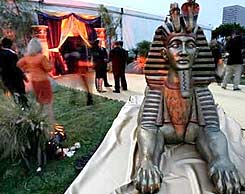The Curse of King Tut

I saw the Treasures of Tutankhamen when it showed at the Los Angeles County Museum of Art (LACMA) in 1978. At the time the entrance fee was $2 (today’s equivalent adjusted for inflation would be $6).
After nearly 30 years the treasures have returned to LACMA as a razzle dazzle Hollywood road show called Tutankhamen and the Golden Age of the Pharaohs. The exhibit bares a whopping $30 admission fee, but that’s only part of the controversy surrounding the show.
I wrote a blog post in December of 2004 titled, Affluent Appropriate Art, that addressed the commercialization of art museums. In that post I said the following:
“As with public libraries, art museums should exist to serve the public. The mission of educating, inspiring, and uplifting society has been the calling of art museums… thus far. The erstwhile objective of enriching the social order has evidently been abandoned in favor of the profit motive.”
The Golden Age exemplifies the very thing I was warning against. LACMA essentially turned over its curatorial powers to a corporate entity – the world’s second largest promoter and producer of mass corporate rock concerts, AEG. The promotion company agreed to pay the five million dollar cost the Egyptian government wanted as the price to show the treasures at LACMA, and in return AEG maintains great control over the exhibit. By outsourcing its curatorial powers, LACMA has reduced itself to a mere venue, but hopes to cash in with new memberships and the notoriety it receives from hosting the exhibition.
If that doesn’t make you wince then perhaps the following quote will. Timothy J. Leiweke, the chief executive officer with AEG, said “Putting on an exhibit like this is similar to a Rolling Stones concert or a farewell tour by Cher.” Even Ted Koppel’s Nightline felt obliged to examine the impact this corporate power shakedown will have on America’s museums in a June 14th broadcast titled The Cost of Admission.
Several museums have turned their backs on hosting this “for profit” road show, including the Metropolitan Museum of Art in New York City. I rarely agree with the Los Angeles Times art critic, Christopher Knight, but when it comes to the commercialization of America’s art museums there is some accord between us. Knight called LACMA’s King Tut exhibit, “an ethically dubious ode to the cash register that gives new meaning to golden age.”
He further disparaged the business arrangement between AEG and the L.A. museum as “a repulsive profit-sharing agreement forged between LACMA and a corporate entertainment conglomerate,” and added that “no other major American art museum was willing to countenance that smarmy scheme.”
Apologists for the corporatization of American museums stress that high ticket prices are no more than what you’d pay to see a movie at your local Cineplex. That viewpoint simply ignores the fact that millions of working poor, students, people living on fixed incomes, and a great many other Americans – can’t afford high ticket prices at art museums.
To celebrate the corporatization of LACMA, the commodification of history and the brilliant scheme of selling glimpses of humanity’s collective heritage to those who can afford the ticket price, a throng of elites held their own “Gold Carpet” premier party at LACMA. The evening before the great unwashed were allowed entry into the exhibit, a gaggle of luminaries that included the Hilton family, film star James Woods, Brendan Fraser (from Hollywood’s The Mummy), and movie star Governor Arnold Schwarzenegger, held a private gala party outside LACMA West.
It was tinseltown meets Tut, and the mood was best exemplified by Sherry Barrat, chief executive officer for the The Northern Trust Bank of California – who, along with L.A. based AEG, is the national sponsor of the traveling exhibit. Barrat stated “Our clients are successful people and they enjoy the arts. They are all about creating legacies and certainly King Tut and the legacy of King Tut is a perfect fit. It’s a wonderful metaphor for what Northern helps our clients do… which is preserve their legacy.” I think I can hear Tutankhamen’s ghost moaning.

To add to the Las Vegas-like glitziness that AEG is so well known for, three so-called “reconstructed” portrait busts of King Tut are part of the Golden Age exhibit. Based on scans of Tut’s mummy, three teams of forensic artists and researchers created the “reconstructions” of the young King – depicting him as a Caucasoid. These busts are pure conjecture when it comes to facial features and skin color, and the “recreations” certainly have nothing to do with scholarship.
Critics call the guesswork representations a travesty of Egyptology, contending such portrayals reinforce the idea that ancient Egypt was not an African civilization. It’s expected that one million people will view the Golden Age at LACMA, and after its LA premier the Tut road show will travel on to the Museum of Art in Fort Lauderdale, the Field Museum in Chicago, and the Franklin Institute in Philadelphia.
It all makes you wish that the story of King Tut’s curse was true.


